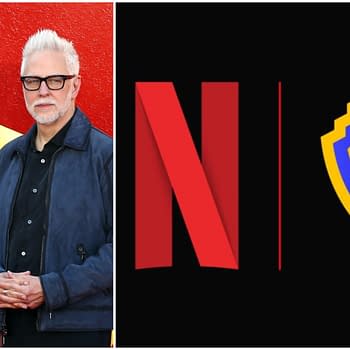Posted in: Comics | Tagged: Comics, entertainment, Paul Gulacy, steven grant, The Rook
The Rook Leaps Through Time Again At Dark Horse – Talking With Steven Grant, Plus Exclusive Preview
When The Rook returns to Dark Horse Presents #14 for a short story this September 16th, and then arrives for its own series in October, it will in some sense be new to me, since I had never met Restin Dane before working on this interview with new series writer Steven Grant. But for many comics readers, this is a recurrence of comics history, since one of the most well-known heroes of Eerie, from Warren publishing, is taking up his mantle as a time-traveller again. As a protagonist built to incorporate cross-genre elements that hint at the Western, the spy-thriller, and the science fiction of time-travel, the Rook is above all things an action hero with plenty of attitude. Steven Grant and artist Paul Gulacy bring him to life again with verve from the very first panel.
Today, we talk with Grant about The Rook and his perspective on comics writing, and also present an exclusive preview of the story that will appear in Dark Horse Presents #14, titled "The Rook: The Gift".
Hannah Means-Shannon: What attracts you to working in a particular genre when it comes to comics? Is it fandom, curiosity about finding new ways to use the features, other factors?
Steven Grant: It varies with the job. Left completely to my own devices, I'll swing toward whatever's the best fit for the idea I want to explore right then. Sometimes the publisher dictates the genre, sometimes there's an artist I want to work with who has leanings I try to accommodate. It could be any number of things. I don't care much about genre for its own sake one way or another. I write quite a few crime comics, for instance, but that's less because I have an interest in crime fiction than that it's often the best vehicle for what I want to say. Genre's overrated; it's a convenience invented by & for marketing departments. In an ideal world, writers wouldn't concern themselves with it at all.
The Rook already exists in an established genre, obviously, though it was one of the earlier genre-bending exercises in comics, so in this case genre wasn't a decision I had to make. The "science fiction western" has become something of a moribund cliché since the original heyday of The Rook so we decided to back off from the western aspect, at least until the feature is re-established. While the gunslinger motif was key to Bill's '70s version – there was an immediate dissonance there that caught the attention – there's nothing in it that's intrinsically necessary to the concept. It's something our version can grow into. If the relaunch gets enough support, we'll get there.

SG: I'm not sure what you mean. I've been doing this for a lot of years, whatever amounts to my process is substantially internalized by now & it was never very formal to begin with. I don't look for similarities with other characters or projects, it's the differences that attract me. I'm very shallow & prone to boredom; I hate doing the same thing twice. But stories start from different kernels – sometimes you start with an idea then look for characters to express it, sometimes you get a character idea then fish for what they're about & what their story is, etc. – I always liken it to the Arthurian concept of the Forest Perilous, where no paths exist & you have to carve your own – then they accrue haphazardly.
A lot of it ends up being trial & error, puzzle-solving. Again, while we monkey with The Rook quite a bit, there are certain constraints that we had to keep in mind as well. So those affect things too. Every project is different & produces a different set of creative demands. "The process" is one of those things that fans & critics try to reverse-engineer, understandably trying to understand it, so its importance becomes vastly overrated. But we work in a product-, not process-, orientated business. What comes out on the page is what's important, how you got there is fairly irrelevant. Starting out it's worth experimenting with many different approaches to see which are most effective for you, but, like I said, past a certain point a lot of it becomes internalized & semi-conscious at best.
When a book is called The Rook, you pretty much know going in The Rook will be the hero, whether you associate that will all the baggage the comics market heaps on "hero" or simply mean the protagonist. There are sets of expectations. How you meet, deny or defeat those expectations shapes the character. When I write completely from scratch, I often don't even know who the "hero" of the story is until I see how things work out. I'm fairly dismissive of our pop cultural concept of "the hero" anyway.

SG: The biggest drawback is the ******* research. Fortunately we now have the Internet, making it relatively quick, not necessarily easy, to not only find information but also send appropriate reference to artists. If you're writing about the future, that's great (usually; we went another direction) because you can make up anything you want. If you're writing about the known past, you're staring down piles of research if you're doing your job properly. The other drawback is the inevitable paradoxes. They can drive you crazy. I decided to just embrace them. Our entire series is predicated on a time paradox now, that the Rook intentionally causes.
On the other hand, if I want to write a story set in the Trojan War, like our short in Dark Horse Presents is, there's no need to convince a publisher to throw away money publishing historical fiction. I can send The Rook there. Problem solved. That's the main joy of it. Theoretically, it allows for a lot of different milieus & situations you might not normally get the chance to work with, bringing different perspectives to the material. We don't get to play that much with that in the first mini, but we already have plans to get much more expansive with the next one. We used the first to sow the seeds for that.
HMS: Can you tell us about what seems like quite an expansive cast of characters in The Rook, and how you developed the personality of our central character?
SG: It's not all that expansive just yet. Most of the characters from Bill's work haven't made their appearance by the end of the mini-series. We have Restin, of course. Manners The Robot is there, but in the deep background. Restin's ancestor, Adam Dane, the inventor who's the unnamed hero of H.G. Wells' The Time Machine, is in quite a bit of it. The series' main villain, Qwarb; we play quite a bit with Restin & Qwarb's criss-crossing timelines. We have a small raft of other villains in the first issue – sort of the Rook Revenge Squad, though we made up all of them on the spot so there's a lot of potential backstory there, though we hint at the origin of one of them in the first issue – but the only other old school character who appears, very late on, is Kate McCall, though we have renamed her Cat.
As for Restin, you have to let characters develop organically. You have to start somewhere, of course; I began with his current situation where our story begins, as a grad student obsessed with trying to crack the mechanics of time travel. It flows out from there. He doesn't have the experience his older self has. He has a far more shallow sense of what he's getting himself into, but he's very smart, and he quickly learns to be adaptable because that's the alternative to death. So he develops a good survival instinct, something to that point he hasn't needed all that much. You figure out what priorities he'd have to have that guide him (or not) through the challenges he'll find himself facing. Again, we had Bill's original to work with. We know what here is, with the young Restin. We know what there is, with Bill's Restin. So what qualities are inherent in him that would get him from here to there, & under what circumstances do they emerge? You start working out the puzzle, & before long the personality emerges.

SG: I've never been sure it works. I generally construct a script by working out the visuals first, maybe with little dialogue notes or roughs here & there – bear in mind it never functions this smoothly or in quite so orderly a fashion as I'm describing – then I'll start laying in dialogue, retooling the visuals as necessary as I go along. The idea is to start with as much information in the visuals as they'll comfortably hold, though my idea of comfortable & an artist's can vary considerably. You theoretically want to avoid exposition as much as possible in dialogue, especially exposition that explains what the reader is looking at. The art should be its own exposition, so dialogue can be a vehicle for character & for non-visual concepts. A third pass for captions lays in whatever information is necessary that can't be comfortably carried by either art or dialogue; you have to find a narrative concept that can allow for it without being too disruptive of the rest of the story. In The Rook, I adopted the idea of Manners The Robot operating as sort of a Greek chorus via a transtime communication device. Finally I go through, look for redundancies to eliminate, look for unnecessary dialogue or bits of dialogue to trim. You can go on forever if you get too obsessive with it. At some point you have to turn it in & let other people decide whether it works. That's why God invented deadlines.
Of course, The Rook is supposed to be an action-adventure series, not a dissertation on time travel. Bill always did have Restin Dane just a bit out of his depth as he learned the ins & outs of time travel, but there was the sense he'd already mastered the basics. We drop him right into the deep end, before he knows what's happening. The story runs away with him; he has to adapt on the fly to situations he can as yet barely begin to comprehend.
HMS: For you, as a comics writer, is there still a personal "fun" element in writing stories that challenge expectations like this one?
SG: I can't say I go much out of my way to challenge expectations. If I do it, it's more natural inclination than design. Mainly I just try to keep myself entertained & hopefully find that angle that can sustain my interest. That's what keeps writing fun. Writing if you're not having fun becomes a terrible struggle, it becomes suffocating. If I wanted to suffocate, I'd work in an office.
HMS: Can you tell us a little about working with artist Paul Gulacy on The Rook so far? What qualities in his work bring the story to life for you?
SG: Paul's someone I've wanted to work with since I saw his first issue of Master Of Kung Fu, well before I went pro. We'd talked about working together for a few years but the opportunity only recently presented itself, when we co-created an original feature we're shopping around now. Then Paul was approached to work on The Rook by Ben Dubay, Bill's heir, & Paul recruited me with Ben's blessing. There wouldn't be any Rook without Paul as far as I'm concerned. A lot of series can get by well enough with fairly generic art, but when you're remodeling a classic you really need a strong, distinctive style, something that says "this is different!" That's Paul's style: strong, distinctive & different. It's very difficult for anyone with eyes to mistake it for anyone else's. Plus he brings a great sense of design & storytelling, tons of experience & an eagerness to constantly try new things; he's a lot more artistically adventurous than he's often given the chance to be these days. He borders on being the perfect collaborator. It's great fun to work with him. He's more than a legend, he's a comics industry treasure, & it's time he experienced a popular renaissance. Hopefully The Rook can pave the way.
You'll find The Rook in Dark Horse Presents #14 arriving September 16th, and currently listed in Previews World with item code: JUL150104
The Rook series #1 arrives on October 21st, and is currently listed in Previews World with item code: AUG150039

















